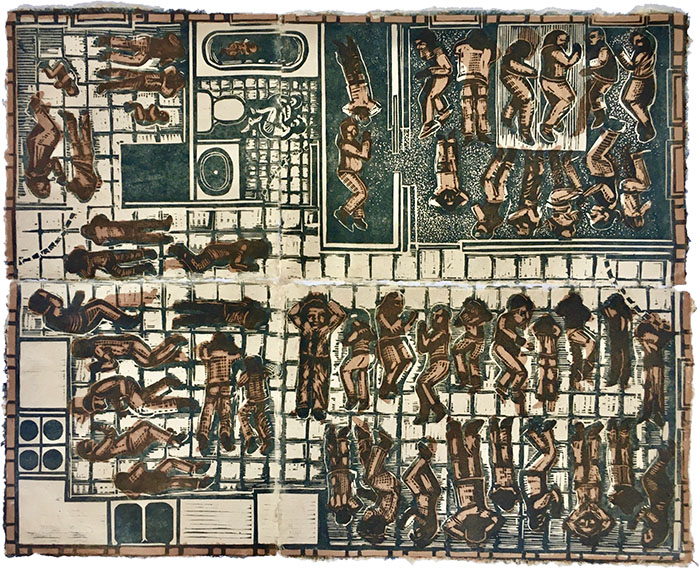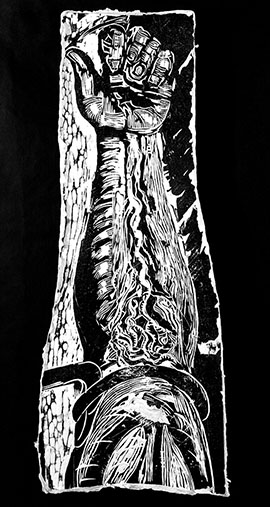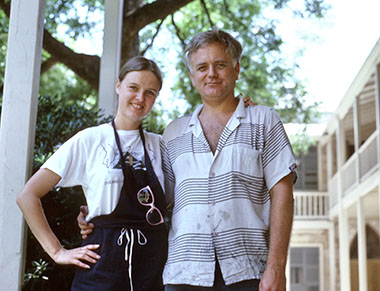Stash House: Rompecabezas



Eric Avery: It was a dream to work with you again at the Southwest School of Art in San Antonio during your winter Texas break from Colorado. Thanks for asking Leo Lee if I could work with you and her class at the SWSA. We've known each other for a long time. Do you remember how we met?
Susan Mackin Dolan: I was hired to help build and run a papermaking studio at what was then called the Southwest Craft Center in San Antonio in 1985. Beck Whitehead was an artist in residence there and worked with me in the paper studio. I left five years later and Beck expanded and directed the program until she retired in 2016. You were friends with Beck and her husband Chuck. In 1985, he had designed the poster for your first San Antonio exhibit "Images of Life and Death." Beck suggested that I invite you to teach a woodcut class in the paper studio. You lived a few hours away, on the Border near Laredo.
EA: I was living in San Ygnacio and making dark prints and casting plaster in my relief printing blocks. The plaster prints were heavy and broke easily and I had the idea of using handmade paper instead. I'd made a woodcut of a starving Somali baby in a Mexican wooden wash bowl that I couldn't print on a sheet of flat paper. You helped me figure out how to use cast paper pulp to print my blocks. That was 1985 and the HIV/AIDS pandemic was spreading in the United States. While waiting 10 days for the results of my first HIV text, I had made a big woodcut of my arm on a rough plank of pecan. It was a really scary time. We made the molded paper woodcut "Blood Test." One of our impressions from that woodcut is now in the print collection of the British Museum.
SMD: That's how we started working together. It took a few trials to figure out how to beat the paper pulp and cast it into carved moulds to capture the cut marks in the blocks. We also had to modify the oil-based ink to print on the wet paper.
EA: I remember you were a very low-tech paper maker. Your approach made papermaking very accessible to me. You are also a printmaker and very process oriented. Working together was fun. We were discovering a new way to use paper and print.
SMD: Figuring out the low tech casting technique with you was pretty exciting, as I had mostly done traditional western papermaking and lithography in graduate school. Over the last ten years, I've been using a modified eastern process during visiting artist gigs in San Antonio.
We started our new project in late 2019, before COVID shut everything down. Our plan: I make the stenciled kozo paper. You make a new print and we include Leo Lee's papermaking students. You proposed making a print related to human trafficking and a stash house that you had read about in the Laredo Morning Times. Why did you want to work on this problem?
EA: I've a long history of working with refugees. After completing my medical training, I worked with Vietnamese refugees in Indonesia, and then I was the medical director in a large refugee camp in Somalia. When I returned to Texas from from Africa in 1981, I took a break from my medical practice to make prints. I'd been "deconstructed" by my experiences and needed to put myself together again. At the time, there were thousands of refugees from the Central American Wars in detention centers in South Texas. I helped organize Amnesty International members and in Laredo, I helped found a not for profit refugee legal assistance project. During this time, HIV/AIDS was spreading in the United States and PWA were dying. When my friends began to die in Houston, I returned to my medical practice to become the HIV psychiatrist at the University of Texas Medical Branch in Galveston. After twenty years, I retired and moved back full time to my studio in San Ygnacio.
SMD: You had a nice paper studio in Galveston, and we stayed in touch. What's it like for you to live in San Ygnacio again, a block from the Rio Grande?
EA: I love being back in my great studio and working full time again on my art making. San Ygnacio is like living in a foreign country in my own country. The Border has changed a lot since the 1980s. The civil chaos and danger in Central America push people to leave everything and head north. There are no easy solutions. Now, after the economic meltdown post COVID, the pressure to move North is even greater.
In 2018, I clipped an article in the Laredo Morning Times about a Stash House in South Laredo that had been busted by Customs and Border Protection (CBP). I had the article with me in January when we met with Leo's class at the SWSA. In the story, there were 73 migrants hiding inside a house, waiting to be moved north. Thinking about how 73 people could sleep in a small house, triggered memories of my work with refugees in Somalia and Indonesia. In 1980, I made this photo of Vietnamese refugees in the cargo hold of Ship Sea Sweep. I also had in mind the great 1788 Brooks Slave Ship broadside. Human cargo. Human trafficking.
When I started making the drawing for my Stash House print, I asked Leo and her students to pose as sleeping migrants. While I met with the students, you were quietly making paper for our project on the other side of the studio. You have mastered a very difficult form of Japanese paper making. Can you explain the process and why you do it?
SMD: I started making paper for my prints 40 years ago, because I wanted it to be more integrated into the prints and couldn't buy the type of paper I needed. I use Japanese kozo, gampi and local plant fibers, cooked and pounded to make the pulp. My sheet forming process is a modified Asian technique and uses contrasting fibers shaped by foam stencils to make images within the sheets of paper. This adds another layer of color and shape to the final printed image.
EA: Because your technique is so difficult, you decided to make four separate sheets of double dipped paper that fit together like a puzzle to print my block. Your paper with two fiber colors reminded me of traditional chiaroscuro print. To make a print, I draw the image onto the printing template, in this case a piece of 25" x 32" linoleum. Then I cut the drawing off block. You needed to make a people stencil to form your sheets so you figured out the floor plan for a one bedroom house and how to fit fifty sleeping migrants on the floor.
SMD: After I made the paper, I returned to Colorado. During the rest of the semester, you were going to meet several more times with Leo's students, who were also working on projects related to human trafficking. When the COVID lockdown happened, Leo's class was interrupted when the school closed. I know that was a setback for you. How did you get through that?
EA: That was the hardest part of this project. I got the pandemic blues and had a hard time getting motivated to finish cutting the block. I couldn't imagine how I was going to register my block to your paper. You were really helpful. Your advice was to be compassionate with myself. Then, I realized that without the pressure of a semester deadline and students' expectations, I could take my time to cut a beautiful linoleum block of the Stash House. I also had the time to draw and cut a second block to make a folio cover to hold the four sheets of printed paper.
I drew an abandoned house in San Ygnacio and, using the cast paper printing technique we had figured out in 1985, I made the folio covers. I found migrant clothes on the Rio Grande riverbank in Laredo, which I collaged inside the folio covers during the printing.
SMD: I remember when we first started conceptualizing the project, I was hesitant to appropriate someone else's story or get in trouble for referencing the trans-Atlantic slave ships. We talked with the students about their family members' migration stories and you also reached out to your friend Sue Coe for her thoughts. She said art can be the most effective tool to expose and depict struggles and contradictions, but it's not the artist's job to resolve them. You both also talked about the artist being a "witness." Can you expand on that idea?
EA: Bearing witness is the narrative function of art. Living on the border I am a witness to what is happening to the migrants and human rights abuses. I didn't want our work to contribute to the narrative that the border is out of control and that we need the Wall to control it. The migration of people across our southern border can be monitored by CBP and virtual technology. Building a wall to solve the problem is like building prison walls that we live inside.
Sue's wise words were a great help. "In any political art you get into trouble and offend people, trouble is the nature of the beast. But art and a search for meaning can't work within polite parameters. It has to test the waters to open a dialog. If the artist's intent is one of integrity and curiosity, rather than corruption and opportunism, it reveals itself in the art. It's a leap of empathy."
I hope this work creates a dialogue, even if it's only about one aspect of these desperate families' struggle for survival. I'm really happy with the finished project and that Beck Whitehead's visiting artist fund allowed us to work together again at the SWSA. We were anxious to present her with a copy from the edition. She received it in August, six months after we began working on Stash House.
Eric Avery lives and works in San Ygnacio, Texas. Susan Mackin Dolan lives and works in Edwards, Colorado. They have been artist friends and collaborators for 35 years.






